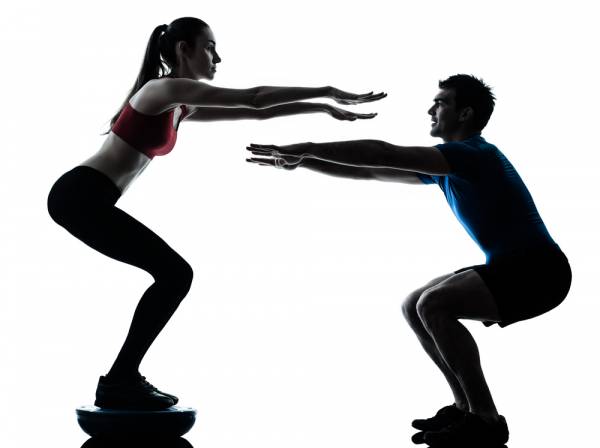One of the conventional tests used to assess explosive power is the vertical jump. A superior vertical jump typically correlates well with leg strength, sprinting speed, and other leg-power activities. Review almost any high school, college, or professional sport testing protocols and you would be hard-pressed to find one that excludes the vertical jump test.
Because the vertical jump is a standard measuring stick, it is an often-researched topic. Recently two studies were conducted to determine how the vertical jump was affected by 1) strength and power training and 2) training on stable versus unstable surfaces.
The first study compared the effects of strength training (ST) and power training (PT) scripts on neuromuscular adaptation and alterations in vertical jump performance, as well as kinetic and kinematic factors (study of motion and the description of motion, respectively). The subjects were forty physically active men (average height: 5’-10”, weight: 165 pounds, and age: 23.5 years). Each subject had at least two years of strength training experience and was assigned to one of three groups: ST, PT, or a control (C) group. Maximum dynamic and isometric strength, cross-sectional area, and muscle activation were assessed pre- and post-test. Additionally, squat jump and countermovement jump performance, kinetic, and kinematic factors were also assessed.
Conclusions of the study:
- Maximum dynamic strength increases were statistically similar for the ST (22.8%) and PT (16.6%) groups.
- Maximum voluntary isometric contraction increases were similar the ST and PT groups.
- There were no changes in muscle activation, although a main time effect for muscle fiber cross-sectional area occurred.
- Static jump height increased following ST and PT due to the faster concentric (raising) phase and a higher rate of force development.
- Countermovement jump height increased only following PT, but no significant kinetic and kinematic changes were evident.
Take home message of study one: ST and PT are equally effective in increasing strength gains, neuromuscular adaptations, changes in jumping movement pattern, and static jump performance. Neither ST nor PT were able to affect the static jump and the countermovement jump movement timing and joint extension sequencing initiation. Therefore, become stronger generally, work on power activities generally, and practice being explosive with exact activity-specific drills.
 The second study compared power outputs in the concentric (raising) phase of squats performed in interval mode on stable and unstable surfaces, respectively. The subjects were sixteen physical education students who randomly performed six sets of eight repetitions of squats on a 1) stable support base and 2) BOSU (unstable) ball, respectively, on different days with a two-minute rest between sets. A 1-repetition maximum (1RM) was obtained for each subject. Repetitions with 70% of the 1RM were then performed under both conditions. Using a computer system, force and velocity were calculated to determine power output.
The second study compared power outputs in the concentric (raising) phase of squats performed in interval mode on stable and unstable surfaces, respectively. The subjects were sixteen physical education students who randomly performed six sets of eight repetitions of squats on a 1) stable support base and 2) BOSU (unstable) ball, respectively, on different days with a two-minute rest between sets. A 1-repetition maximum (1RM) was obtained for each subject. Repetitions with 70% of the 1RM were then performed under both conditions. Using a computer system, force and velocity were calculated to determine power output.
Not surprising, results showed significantly lower power outputs when squats were performed on an unstable surface as compared to a stable support base. In the initial set, mean power in the concentric phase decreased more with the unstable surface compared to the stable surface during the squats (10.3 and 7.2%, respectively). In the last set, the mean power reduction resulted in nosignificant differences between the BOSU ball and the stable surface (11.4 and 9.6%, respectively).
Conclusion of the study: Power output during resistance exercises is more significantly compromised when using unstable surfaces as compared to stable conditions. If instability resistance exercises are used in a training program, understand maximal force production will not be realized.
My recommendations based on the results of these studies:
- To improve leg power, use resistance training to increase strength.
- Perform strengthening exercises on stable surfaces to maximize force output.
References:
1. Lamas, L; Ugrinowitsch, C; Rodacki, A; Pereira, G; Mattos, E.C.; Kohn, A.F., and V. Tricoli, “Effects of Strength and Power Training on Neuromuscular Adaptations and Jumping Movement Pattern and Performance,” Journal of Strength and Conditioning Research 12 (2012): 3335-3344.
2. Zemková, Erika; Jele?, Michal; Ková?iková, Zuzana; Ollé, Gábor; Vilman, Tomáš, and Hamar, Dušan, “Power Outputs in the Concentric Phase of Resistance Exercises Performed in the Interval Mode on Stable and Unstable Surfaces.” Journal of Strength & Conditioning Research 26 (2012): 3230–3236.
Photos courtesy of Shutterstock.






